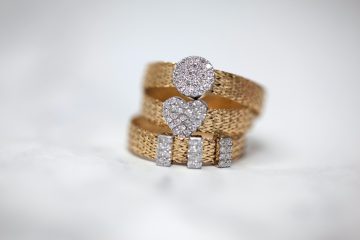Are you going to buy a diamond? Buying a diamond can be a big investment. With that said, there are a lot of things you want to consider when buying diamonds to ensure that you get the most bang for your buck. There are many things that affect the quality of diamonds, so in this guide, we will help you understand the factors that are important for a diamond’s quality.
Which Carat should you have
What is a carat? One carat is a weight, 0.2 grams, so for example, 5 carat is 1 gram. Don’t mix this up with Carat in metal, who mentions how much gold is in a piece of jewelry. Most women, of course, want a diamond as large as possible, many want a diamond over a certain even limit, for example, 0.5 or 1 carat. If you are smart, then you can take advantage of this and buy one just under any great even weight to save several thousand dollars. Stay away from cheap diamonds of exactly 1 Carat or other even sizes, then they are almost always sanded just to not go under a specific weight instead of being sanded for the best luster.
Everything above 0.3 carats can be seen as above average, above 0.5 and it is starting to get really interesting, you come up around 1 carat, that’s quite a diamond.
What diamond shape?
It is, for the most part, a question of what you prefer, all grindings and cuts have their own disadvantages. Round brilliant-cut diamonds are created to be seen as the most beautiful, so the light bounces optimally on and inside the stone, and around 80% choose round brilliant cut diamonds.
After round diamonds, square diamonds are most common and there are Princess cuts or princess-cut diamonds that account for the majority of the square diamonds sold. Princess-cut diamonds have become extremely modern in recent years and more and more such types of diamonds are constantly in demand.
Round diamonds are usually the most expensive per carat if all else is equal, this is because there will be more “waste” when grinding a round diamond than for example when you cut one of the square diamonds.
Which grinding?
A good cut diamond is much more beautiful to look at and even an unexperienced can see the difference between the very best grinding Excellent versus one that is Very Good. Never settle for anything less than Very Good, no matter how low your budget is.
What color?
The answer is that it depends. The color is graded from D down to Z where D is completely transparent, Z is yellow / brown in color, note that it is not Fancy yellow or Fancy brown, so there is no powerful tone that many want.
If you buy Wesselton (H) or up, the diamond will be perceived as completely un-colored if you look at it with the naked eye when it is caught in a ring, and that is how you will look at it every day, right? So why pay more for something you won’t appreciate. Some still want to buy diamonds that are graded the highest just for the sake of having the best. Sure the diamond is whiter and worth more but there is not something you will be able to see until you remove the diamond and compare it to so-called “master stones”.
If you have a ring in colored gold, for example red gold, yellow gold or rose gold, you can lower your color requirements a bit and settle for IJ (Top Crystal / Crystal) this as the diamond takes up colors in its surroundings regardless and yet will not be perceived as completely transparent. .
If you buy a silver ring (White Gold, Platinum, Palladium), choose a diamond graded Wesselton and up for the best value.
If you buy a ring in red gold, yellow gold or rose gold, choose a diamond graded Crystal (J) and upwards for best value.
What clarity?
This is the characteristic that people overestimate, this is the part of the diamond that plays the least role. Of course, you don’t want a diamond with large “grit” in it, but paying the difference on a diamond that is graded SI1 versus a VVS1 or even better is just stupid if you do it to get a diamond that looks more beautiful.
In that case, save your money and buy a larger diamond, a ring in platinum instead of one in white gold or to be able to stay a better hotel during your honeymoon.
Almost all diamonds graded over SI1 are perfectly clear with the naked eye, although some diamonds graded SI2 can be of excellent value but then you often need to see them to ensure that they are completely clear.
Fluorescence, polishing, and symmetry affects the value but does not affect how a diamond is experienced to a great extent, content with polishing and symmetry that is Good or better. Certain diamonds (3%) with high fluorescence can be experienced as milky so be sure to keep one that does not have high fluorescence if you buy a diamond with a color-graded from DG, you buy a diamond graded from H and down can, on the contrary, a strong blue fluorescence help to make the diamond feel whiter.



